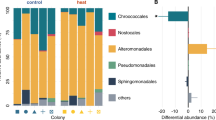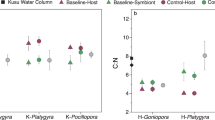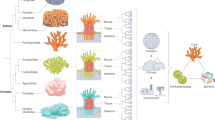Abstract
Coral reefs are at serious risk due to events associated with global climate change. Elevated ocean temperatures have unpredictable consequences for the ocean’s biogeochemical cycles. The nitrogen cycle is driven by complex microbial transformations, including nitrogen fixation. This study investigated the effects of increased seawater temperature on bacteria able to fix nitrogen (diazotrophs) that live in association with the mussid coral Mussismilia harttii. Consistent increases in diazotroph abundances and diversities were found at increased temperatures. Moreover, gradual shifts in the dominance of particular diazotroph populations occurred as temperature increased, indicating a potential future scenario of climate change. The temperature-sensitive diazotrophs may provide useful bioindicators of the effects of thermal stress on coral reef health, allowing the impact of thermal anomalies to be monitored. In addition, our findings support the development of research on different strategies to improve the fitness of corals during events of thermal stress, such as augmentation with specific diazotrophs.
Similar content being viewed by others
Log in or create a free account to read this content
Gain free access to this article, as well as selected content from this journal and more on nature.com
or
References
Aggarwal P, Chaudhary K . (1995). Biological nitrogen fixation at elevated temperature in different Azospirillum species and strains. Biol Fertil Soils 20: 260–262.
Bach HJ, Tomanova J, Schloter M, Munch JC . (2002). Enumeration of total bacteria and bacteria with genes for proteolytic activity in pure cultures and in environmental samples by quantitative PCR mediated amplification. J Microbiol Meth 49: 235–245.
Barott KL, Rohwer FL . (2012). Unseen players shape benthic competition on coral reefs. Trends Microbiol 20: 621–628.
Bérauda E, Gevaertb F, Rottiera C, Ferrier-Pagèsa C . (2013). The response of the scleractinian coral Turbinaria reniformis to thermal stress depends on the nitrogen status of the coral holobiont. J Exp Biol 216: 2665–2674.
Bourne DG, Iida Y, Uthicke S, Smith-Keune C . (2008). Changes in coral-associated microbial communities during a bleaching event. ISME J 2: 350–363.
Burke L, Reytar K, Spaulding M, Perry A . (2011) Reefs at Risk Revisited. World Resources Institute.
Caporaso JG, Kuczynski J, Stombaugh J, Bittinger K, Bushman FD, Costello EK et al. (2010). QIIME allows analysis of high-throughput community sequencing data. Nat Methods 7: 335–336.
Charlson RJ, Lovelock JE, Andreae MO, Warren SG . (1987). Oceanic phytoplankton, atmospheric sulfur, cloud albedo and climate. Nature 326: 655–661.
Chou HH, Holmes M . (2001). DNA sequence quality trimming and vector removal. Bioinformatics 17: 1093–1104.
Clarke KR, Gorley RN . (2006) PRIMER 6th edn. PRIMER-E Ltd.: Plymouth, UK.
Cunning R, Baker AC . (2013). Excess symbionts increase the susceptibility of reef corals to bleaching. Nat Clim Change 3: 259–262.
De Castro AP, Araujo SD Jr, Reis AM, Moura RL, Francini-Filho RB, Pappas G Jr et al. (2010). Bacterial community associated with healthy and diseased reef coral Mussismilia hispida from eastern Brazil. Microb Ecol 59: 658–667.
Falkowski PG, Dubinsky Z, Muscatine L, McCloskey L . (1993). Population control in symbiotic corals. Bioscience 43: 606–611.
Falkowski PG, Dubinsky Z, Muscatine L, Porter JW . (1984). Light and the bioenergetics of a symbiotic coral. Bioscience 34: 705–709.
Hewson I, Moisander PH, Morrison AE, Zehr JP . (2007). Diazotrophic bacterioplankton in a coral reef lagoon: phylogeny, diel nitrogenase expression and response to phosphate enrichment. ISME J 1: 78–91.
Hoegh-Guldberg O, Bruno JF . (2010). The impact of climate change on the world’s marine ecosystems. Science 328: 1523–1528.
Hoegh-Guldberg O, Mumby PJ, Hooten AJ, Steneck RS, Greenfield P, Gomez E et al. (2007). Coral reefs under rapid climate change and ocean acidification. Science 318: 1737–1742.
Keller MD, Bellows WK, Guillard RRL . (1989). Dimethyl sulfide production in marine phytoplankton. In: Saltzman ES, Cooper WJ (eds) Biogenic Sulfur in the Environment. American Chemical Society: Washington, USA, pp 167–182.
Knowlton N, Rohwer F . (2003). Multispecies microbial mutualisms on coral reefs: the host as a habitat. Am Nat 162: 51–62.
Koop K, Broadbent AD, Booth D, Brodie J, Bucher D, Capone D et al. (2001). ENCORE: The effect of nutrient enrichment on coral reefs. Synthesis of results and conclusions. Mar Pollut Bull 42: 91–120.
Lema KA, Willis BL, Bourne DG . (2012). Corals form characteristic associations with symbiotic nitrogen-fixing bacteria. Appl Environ Microb 78: 3136–3144.
Lesser MP, Falcon LI, Rodriguez-Roman A, Enriquez S, Hoegh-Guldberg O, Iglesias-Prieto R . (2007). Nitrogen fixation by symbiotic cyanobacteria provides a source of nitrogen for the scleractinian coral Montastraea cavernosa. Mar Ecol Prog Ser 346: 143–152.
Miranda RJ, Cruz ICS, Leão ZMAN . (2013). Coral bleaching in the Caramuanas reef (Todos os Santos Bay, Brazil) during the 2010 El Niño event. Latin Am Aquat Res 41: 351–360.
Mouchka ME, Hewson I, Harvell CD . (2010). Coral-associated bacterial assemblages: current knowledge and the potential for climate-driven impacts. Integr Comp Biol 50: 662–674.
O’Neil J, Dennison WC . (2005). Lyngbya majuscula in Southeast Queensland waterways. In Abal EG, Dennison WC (eds) Healthy Waterways—Healthy Catchments. South East Queensland Regional Water Quality Strategy, Brisbane City Council.. Moreton Bay Waterways and Catchments Partnerships: Brisbane, Queensland, Australia, pp 119–148.
O'Neil JM, Capone DG . (2008). Nitrogen cycling on coral reefs. In: Capone DG, Carpenter EJ, Bronk DA, Mulholland MR (eds) Nitrogen in the Marine Environment. Elsevier Press: The Netherlands, pp 949–989.
Olson ND, Ainsworth TD, Gates RD, Takabayashi M . (2009). Diazotrophic bacteria associated with Hawaiian Montipora corals: diversity and abundance in correlation with symbiotic dinoflagellates. J Exp Mar Biol Ecol 371: 140–146.
Paerl HW, Huisman J . (2008). Blooms like it hot. Science 320: 57–58.
Paul VJ, Thacker RW, Banks K, Golubic S . (2005). Benthic cyanobacterial bloom impacts the reefs of South Florida (Broward County, USA). Coral Reefs 24: 693–697.
Pereira e Silva MC, Semenov AV, van Elsas JD, Salles JF . (2011). Seasonal variations in diversity and abundance of diazotrophic communities across soils. FEMS Microbiol Ecol 77: 57–68.
Poly F, Monrozier LJ, Bally R . (2001). Improvement in the RFLP procedure for studying the diversity of nifH genes in communities of nitrogen fixers in soil. Res Microbiol 152: 95–103.
Raina J, Dinsdale E, Willis B, Bourne D . (2010). Do the organic sulfur compounds DMSP and DMS drive coral microbial associations? Trends Microbiol 18: 101–108.
Ramos AG, Martel A, Codd GA, Soler E, Coca J, Redondo A et al. (2005). Bloom of the marine diazotrophic cyanobacterium Trichodesmium erythraeum in the Northwest African upwelling. Mar Ecol Prog Ser 301: 303–305.
Reshef L, Koren O, Loya Y, Zilber-Rosenberg I, Rosenberg E . (2006). The coral probiotic hypothesis. Environ Microbiol 8: 2068–2073.
Rohwer F, Seguritan V, Azam F, Knowlton N . (2002). Diversity and distribution of coral-associated bacteria. Mar Ecol Prog Ser 243: 1–10.
Rosenberg E, Koren O, Reshef L, Efrony R, Zilber-Rosenberg I . (2007). The role of microorganisms in coral health, disease and evolution. Nat Rev Microbiol 5: 355–362.
Santos HF, Carmo FL, Leite DCA, Jesus HE, Maalouf PC, Almeida C et al. (2012). Comparison of different protocols for the extraction of microbial DNA from reef corals. Braz J Microb 43: 517–527.
Schreiber U . (2004). Pulse-amplitude-modulation (PAM) fluorometry and saturation pulse method: an overview. In: Papageorgiou GC, Govindjee (eds) Advances in Photosynthesis and Respiration. Springer: The Netherlands, pp 279–319.
Selig ER, Harvell CD, Bruno JF, Willis BL, Page CA, Casey KS et al. (2006). Analyzing the relationship between ocean temperature anomalies and coral disease outbreaks at broad spatial scales. In: Phinney JT, et al. (eds) Coral Reefs and Climate Change: Science and Management. American Geophysical Union: Washington, USA, pp 111–128.
Simonet P, Grosjean MC, Misra AK, Nazaret S, Cournoyer B, Normand P . (1991). Frankia genus-specific characterization by polymerase chain reaction. Appl Environ Microbiol 57: 3278–3286.
Slezakl DM, Puskaric S, Herndll GJ . (1994). Potential role of acrylic acid in bacterioplankton communities in the sea. Mar Ecol Prog Ser 105: 191–197.
Sutherland KP, Porter JW, Torres C . (2004). Disease and immunity in Caribbean and Indo-Pacific zooxanthellate corals. Mar Ecol Prog Ser 266: 273–302.
Takahashi S, Nakamura T, Sakamizu M, van Woesik R, Yamasaki H . (2004). Repair machinery of symbiotic photosynthesis as the primary target of heat stress for reef-building corals. Plant Cell Physiol 45: 251–255.
Taketani RG, Santos HF, van Elsas JD, Rosado AS . (2009). Characterization of the effect of a simulated hydrocarbon spill on diazotrophs in mangrove sediment mesocosm. Antonie van Leeuwenhoek 96: 343–354.
Tamura K, Dudley J, Nei M, Kumar S . (2007). MEGA4: Molecular Evolutionary Genetics Analysis (MEGA) software version 4.0. Mol Biol Evol 24: 1596–1599.
Van Alstyne KL, Schupp P, Slattery M . (2006). The distribution of dimethylsulfoniopropionate in tropical Pacific coral reef invertebrates. Coral Reefs 25: 321–327.
Wild C, Woyt H, Huettel M . (2005). Influence of coral mucus on nutrient fluxes in carbonate sands. Mar Ecol Prog Ser 287: 87–98.
Acknowledgements
We thank Conselho Nacional de Desenvolvimento Científico e Tecnológico (CNPq), Petrobras Ambiental, Fundação de Amparo à Pesquisa do Estado do Rio de Janeiro (FAPERJ), Coordenação de Aperfeiçoamento de Pessoal de Nível Superior (CAPES), Coral Vivo Project and its sponsors (Petrobras and Arraial d’Ajuda Eco Parque) and Eduardo Fonseca for their support. The authors would also like to thank Professor Andrew Macrae (IMPPG/UFRJ) and Professor Ian Head (Newcaslte University, UK) for critical reading of the manuscript.
Author information
Authors and Affiliations
Corresponding authors
Ethics declarations
Competing interests
The authors declare no conflict of interest.
Rights and permissions
About this article
Cite this article
Santos, H., Carmo, F., Duarte, G. et al. Climate change affects key nitrogen-fixing bacterial populations on coral reefs. ISME J 8, 2272–2279 (2014). https://doi.org/10.1038/ismej.2014.70
Received:
Revised:
Accepted:
Published:
Issue date:
DOI: https://doi.org/10.1038/ismej.2014.70
Keywords
This article is cited by
-
Viral predation pressure on coral reefs
BMC Biology (2023)
-
Acclimatization of a coral-dinoflagellate mutualism at a CO2 vent
Communications Biology (2023)
-
Marine Heatwave Caused Differentiated Dysbiosis in Photosymbiont Assemblages of Corals and Hydrocorals During El Niño 2015/2016
Microbial Ecology (2023)
-
A carbon cycling model shows strong control of seasonality and importance of sponges on the functioning of a northern Red Sea coral reef
Coral Reefs (2023)
-
Bacterial communities associated with corals out-planted on the Great Barrier Reef are inherently dynamic over space and time
Marine Biology (2023)



